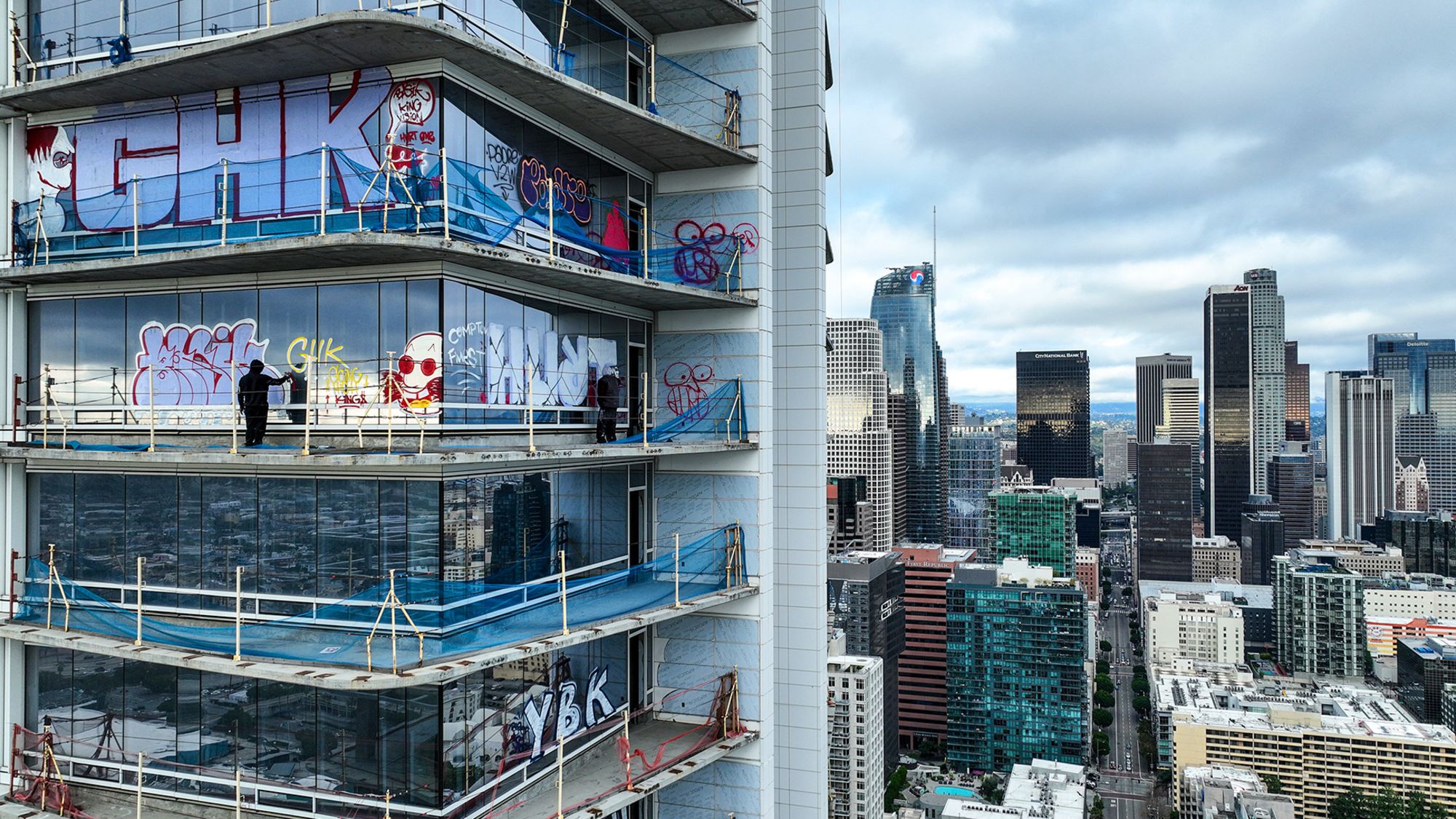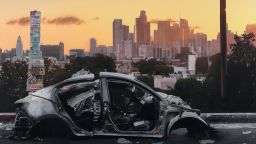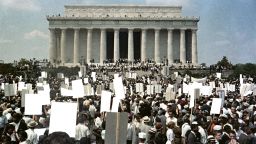Climbing up abandoned, unfinished floors and tightrope walking across balcony ledges, backpacks clanging with cans of alkyd and acrylic, a collective of Los Angeles graffiti artists have transformed their craft beyond urban aesthetics to champion community issues.
Their choice of canvas: Oceanwide Plaza in Downtown LA. Occupying over a full square city block, the plaza was imagined as a vast mixed-use building project, offering city residents over 500 lavish condominiums, a five-star hotel, retail spaces, restaurants and a private 2-acre park.
However, construction on the $1 billion project, which began in 2015, was shelved after the Chinese-backed contractor Oceanwide Holdings ran out of funding in 2019 — and it has lain unfinished ever since.
The plaza’s status — and potential — as an eye-catching venue for their work spread by word of mouth within the graffiti community in recent months. Security at the site was known to be lax, an important detail as accessing the plaza’s towers and other buildings constitutes trespassing. (The Los Angeles City Attorney confirmed to CNN that, as of April 3, criminal charges have been filed against 23 individuals, for violations including trespassing and possession of vandalism tools.)
“It was like a gift from the graffiti gods… A giant canvas in the middle of downtown,” tagger ENDEM told CNN, speaking on behalf of himself and his graffiti crew, NCT. “We were like, ‘Let’s do it right. Let’s do it as if the whole world is going to see this.’”
Historically, graffiti has often been used as protest art. While the practice dates back thousands of years, it’s most commonly viewed in a contemporary context (within graffiti’s “modern” era, which dates back to the 1960s and 70s) as a creative vehicle for challenging societal norms and inequities — whether on the Berlin Wall in Germany or subway cars in New York City; whether painted by anonymous artists or well-known figures like Keith Haring or Banksy, even if the latter is, technically, anonymous himself.
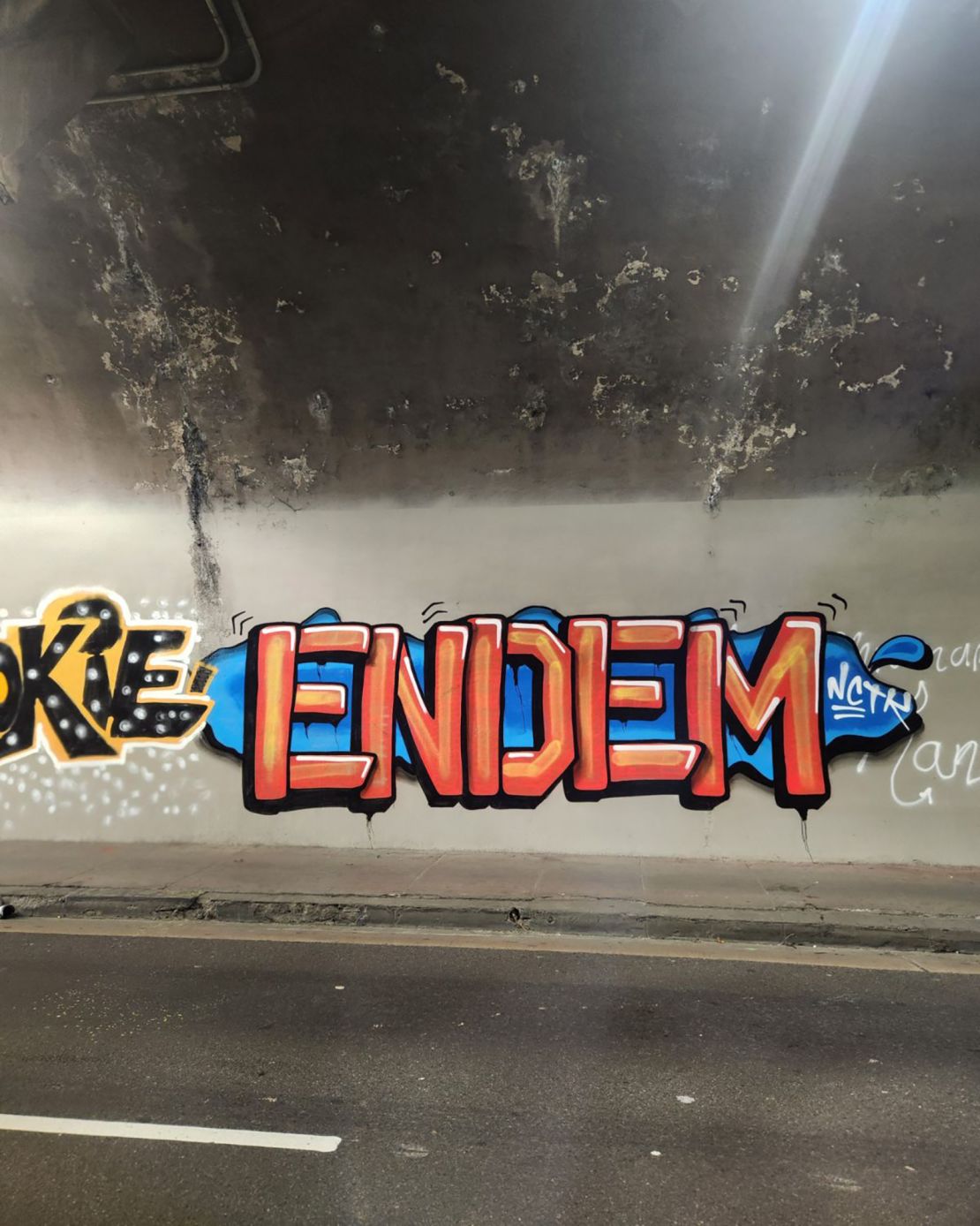
Still, neither ENDEM nor any of the other artists involved realized how famous their work on the Oceanside towers would become.
Sharing his artwork on Instagram on January 31, a video from ENDEM quickly racked up tens of thousands of views: Vibrant images of bright block lettering splayed across the building’s exterior paired with footage from the inside — the artist posing with shots of his spray paint cans, poised above the cityscape. The viral footage, among other visuals shared on social media, quickly opened the floodgates. Hitting Oceanside became a mark of credibility in the graffiti world; by mid-February, the number of tags and other graffiti pieces there were multiplying overnight.
“It was an open house people going in and out. It was beautiful. It was like graffiti paradise,” ENDEM said. “It felt exactly like the streets, but concentrated.”
Transformed in part into an art installation, Oceanwide became an opportunity for the graffiti artists to leave a message to the city below, and a call-out to policy makers who leave buildings to rot.
“Graffiti shows you where the city hurts,” Roger Gastman, owner and founder of the LA-based arts organization Beyond the Streets, told CNN. Renowned for its large-scale exhibitions, immersive educational programs, pop-up events and partnerships, Beyond the Streets works to educate and celebrate the diverse dimensions of graffiti as a medium.
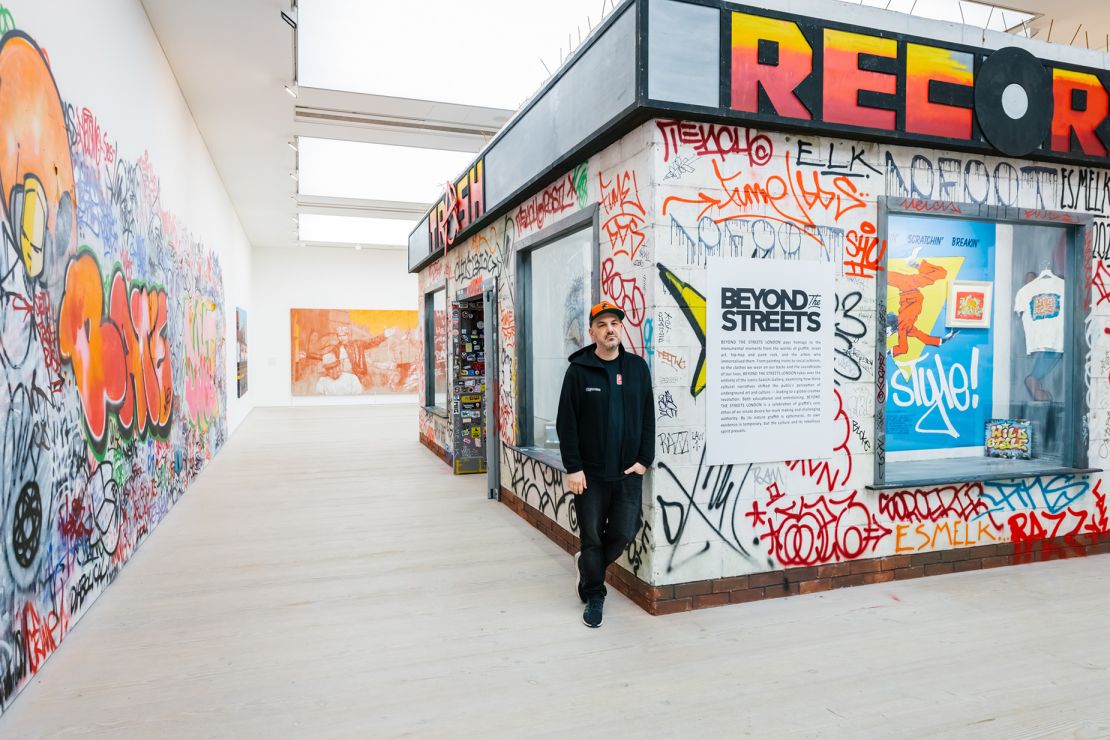
To him, the mission of graffiti is clear: to challenge, educate, and redefine public perception of the medium.
Earl Ofari Hutchinson, president of The Los Angeles Urban Policy Roundtable, a nonpartisan public policy forum for civic participation and education, sees the abandoned towers as amplifying the social issues of the community they are situated in, connecting the graffiti-laden structures to the urban blight that surrounds them in LA’s Skid Row.
Skid Row is a 50-block sector of downtown LA where between 8,000 and 11,000 unhoused people live in challenging, often squalid conditions.
“You’ve got tens of thousands of people displaced because of over urban development. And as a result of that, they’re on the streets,” Hutchinson told CNN, noting that the homeless population in Los Angeles is continuing to grow. (The Los Angeles Housing Services Authority reports a 9% increase in homelessness in LA county in 2023 and a 10% increase in the city from 2022.) “Now, set right in the middle of that, you have… a development that will never be completed.”
“What you have here is a classic urban nightmare brought on by very poor policies — fiscal, financial, budgetary and political problems (in) a city that has just gone off the rails in terms of over-development and lack of affordability,” Hutchinson added.
Still, Hutchinson is no fan of the graffiti either. To him, and many other LA residents who have said they disapprove of the “vandalism,” the plaza is a sore sight for eyes.
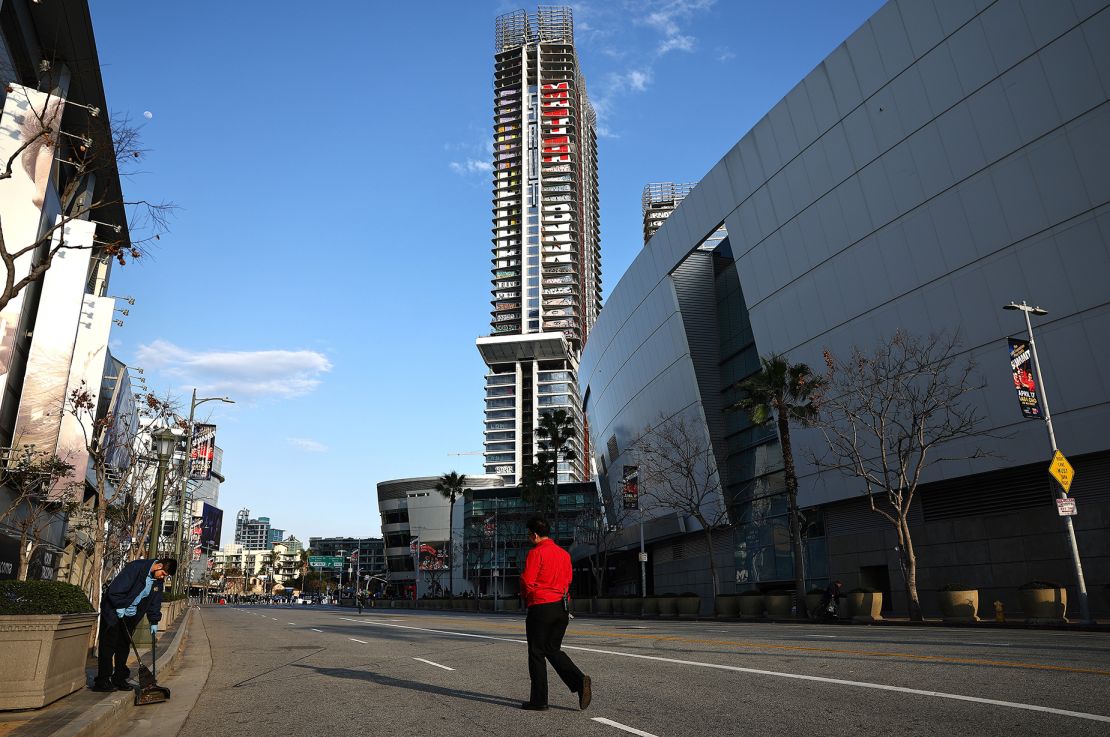
“The problem is you’re talking about violating public space and with no permission… that doesn’t fly with me,” Hutchinson said. “The fact of the matter is, the public has not given you approval. (And) the general public has to pay for the removal.”
Costs currently borne by the taxpayer at the Oceanwide Plaza site include the security details provided by the LAPD as well as the graffiti cleanup Hutchinson highlights.
(“This has strained our deployment,” LAPD Chief Michel Moore said during a February meeting of the Los Angeles City Council. “We have called in some officers on an overtime basis so that we can provide for these added patrols or station them at that site to deter vandals and others from gaining access.”)
Clean teams working in the neighborhoods surrounding Oceanwide remove on average some 2,000 square feet of graffiti per week, with that figure growing in recent months.
“People forget that people live here. People own businesses here and they don’t want to have to spend the time and money to clean it up,” said Blair Besten, executive director of the Historic Core of Downtown Los Angeles, an organization which works to improve the quality of life in downtown neighborhoods. The Historic Core prioritizes street sweeping, trash collection — and graffiti removal.
“I would hardly call what they’re doing art,” Besten argued of the Oceanwide taggers. “It’s pretty sloppy and quick. They come in fast and they knock it out and they leave.”
But to Gastman, graffiti is a powerful form of expression, and a call-to-action — particularly for those who emanate from struggles within home life, gang life or societal turmoil. Graffiti culture can offer an unexpected support system for those the city has abandoned, Gastman said. It becomes a platform for them to make their voices heard.
“In graffiti culture, a lot of us know each other. We’re all friends. We have the same mentality — we’re just trying to get up. We’re just trying to get noticed,” explained ENDEM.
In the midst of an addiction that led to his rock bottom, graffiti became his lifeline, he explained.
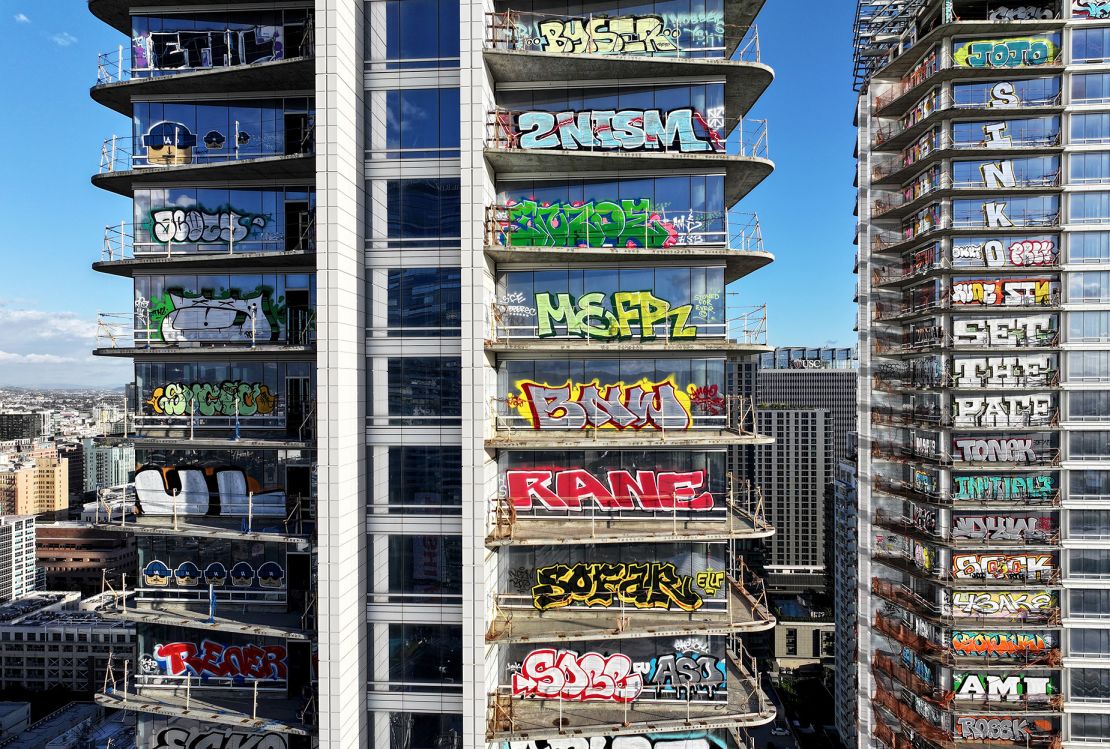
“I was at my lowest of lows, still trying to stay sober, I needed some type of outlet,” he told CNN. “Graffiti is something that you can hold on to. Its bigger than me, its everyone, it’s a community.”
In this, ENDEM believes that the beauty of Oceanwide isn’t tangible. Rather, it lies in the birth of a new generation of graffiti writers.
“They can erase the graffiti on buildings, but they can never erase the impact that it has on the city of Los Angeles and the world,” he said.
“There’s a lot to it. Yes, it’s vandalism. Yes, it’s art, and it’s everything in between,” Gastman concluded. “This is a real culture. It’s not going anywhere.”
